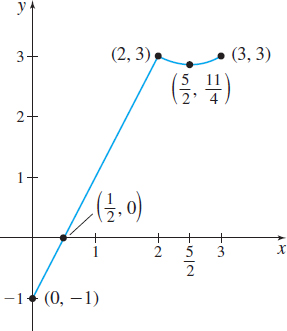EXAMPLE 4Finding Absolute Maximum and Minimum Values
Find the absolute maximum value and absolute minimum value of the function f(x)={2x−1if0≤x≤2x2−5x+9if2<x≤3
Solution The function f is continuous on the closed interval [0,3]. (You should verify this.) To find the absolute maximum value and absolute minimum value, we follow the three-step procedure.
Step 1 Find the critical numbers in the open interval (0,3):
270
The one-sided limits are not equal, so the derivative does not exist at 2; 2 is a critical number.

Figure 18 \begin{equation*} f(x) =\left\{\begin{array}{lll} 2x-1&{\rm if}&0\leq x\leq 2\\[4pt] x^{2}-5x+9&{\rm if}&2 < x \leq 3 \end{array}\right. \end{equation*}
Step 2 Evaluate f at the critical numbers \dfrac{5}{2} and 2 and at the endpoints 0 and 3.
| x | {f(x)} | {f(x)} | |
|---|---|---|---|
| 0 | 2\cdot 0-1 | -1 | \longleftarrow absolute minimum value |
| 2 | 2\cdot 2-1 | 3 | \longleftarrow absolute maximum value |
| \dfrac{5}{2} | \left( \dfrac{5}{2}\right) ^{\!\!2}-5\left( \dfrac{5}{2}\right) +9=\dfrac{25}{4}-\dfrac{25}{2}+9 | \dfrac{11}{4} | |
| 3 | 3^{2}-5\cdot 3+9=9-15+9 | 3 | \longleftarrow absolute maximum value |
Step 3 The largest value 3 is the absolute maximum value; the smallest value -1 is the absolute minimum value.